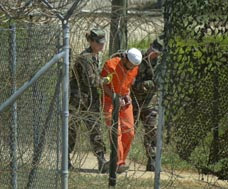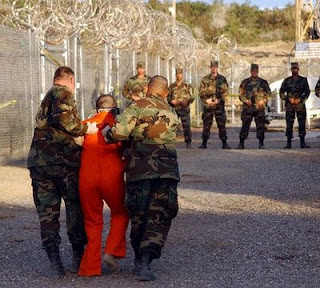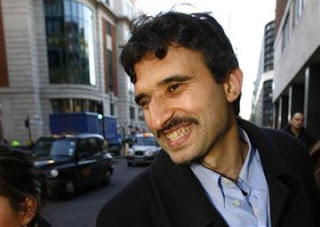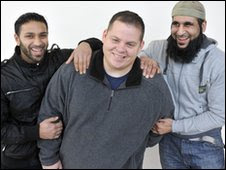Tuesday, February 2, 2010
This Is A Man: The Defiance of Omar Deghayes
 Blinded, bloodied, but unbowed: Libyan-born British citizen Omar Deghayes, imprisoned and tortured for years at Gitmo, seen here shortly before his release.
Blinded, bloodied, but unbowed: Libyan-born British citizen Omar Deghayes, imprisoned and tortured for years at Gitmo, seen here shortly before his release. “What stuck in the minds of these men who had become murderers was simply the notion of being involved in something historic, grandiose, unique (“a great task that occurs once in two thousand years”), which must therefore be difficult to bear. This was important, because the murderers were not sadists or killers by nature; on the contrary, a systematic effort was made to weed out all those who derived physical pleasure from what they did….
Hence the problem was how to overcome not so much their conscience as the animal pity by which all normal men are affected in the presence of physical suffering. The trick used by Himmler — who apparently was rather strongly afflicted by these instinctive reactions himself — was very simple and probably very effective; it consisted in turning these instincts around, as it were, in directing them toward the self. So that instead of saying: What horrible things I did to people!, the murderers would be able to say: What horrible things I had to watch in the pursuance of my duties, how heavily the task weighed upon my shoulders!” —
Hannah Arendt, Eichmann in Jerusalem “The prisoners held at Guantanamo Bay during the war on terror have attacked their military guards hundreds of times…. [One] detainee `reached under the face mask of an IRF (Initial Reaction Force) team member’s helmet and scratched his face, attempting to gouge his eyes,’ states a May 27, 2005, report on an effort to remove a recalcitrant prisoner from his cell. `The IRF team member received scratches to his face and eye socket area,’ the [Pentagon] report said. ” —
“The prisoners held at Guantanamo Bay during the war on terror have attacked their military guards hundreds of times…. [One] detainee `reached under the face mask of an IRF (Initial Reaction Force) team member’s helmet and scratched his face, attempting to gouge his eyes,’ states a May 27, 2005, report on an effort to remove a recalcitrant prisoner from his cell. `The IRF team member received scratches to his face and eye socket area,’ the [Pentagon] report said. ” —
Associated Press, July 31, 2006
Omar Deghayes had no face mask when he was bound in chains and buried beneath a scrum of armored guards. Pinned down and unable to flee or protect himself, Deghayes felt a pair of fingers probe into his eye sockets.
As the assailant, his fingers forged by sadistic purpose into implements of mutilation, tore and gouged at his eyes, Deghayes suppressed the scream that was gathering in his throat out of determination not to concede anything to his tormentors.
While Deghayes resisted in silence, the officer presiding over the torture commanded his underling to press harder. The victim was determined to resist; his jailers were determined to break him. Deghayes won that battle, but it cost him the sight in his right eye.
Today, following more than six years of constant degradation and torture in the Caribbean gulag described by the flagitious gasbag Rush Limbaugh as “Club Gitmo,” Deghayes is permanently disfigured. His useless eye is permanently shut and his nose, broken through repeated beatings, is visibly scarred and noticeably skewed to his right.
Omar’s hideous wounds are tokens of honor attesting to his victory in what was truly a holy war against the world’s most powerful terrorist syndicate, the United States Government.
“A lot of the things in his character seem to have deepened, like rebellion and resistance and not accepting oppression,” comments Omar’s brother Abubaker in describing the changes wrought by six years of imprisonment and abuse. “I think they became more rooted in him rather than being beaten out of him.”
The seeds of Omar’s admirably defiant personality were probably planted by the example of his father, a Libyan attorney who distinguished himself as an enemy of Gaddhafi’s regime and was murdered by the dictator’s secret police as a result. At one point, Libyan and American intelligence agents engaged in a bidding war to buy Deghayes from the bounty hunters who had captured him. It’s difficult to imagine that Omar’s suffering would have been much worse had the Libyans won that auction.
Several years ago, the Landmark Legal Foundation, a litigation firm headed by the deranged rant-radio personality Mark Levin, filed a Freedom of Information Act request to compel the Pentagon to release a report on alleged abuses committed at Gitmo.
The “abuses” in question were supposedly committed by the detainees against the guards. “Lawyers for the detainees have done a great job painting their clients as innocent victims of U.S. abuse when the fact is that these detainees, as a group, are barbaric and extremely dangerous,” insisted Levin. “They are using their terrorist training on the battlefield to abuse our guards and manipulate our Congress and our court system.” (Emphasis added.)
Levin, a person to and from whom lies come easily (imagine a genetic hybrid of Joseph Goebbels and Lazar Kaganovich, and you’ve got Levin), was lying. Fewer than ten percent of those detained at Gitmo had any plausibly alleged connection to terrorism of any kind, much less extensive battlefield training in the tactics of asymmetrical warfare.
As a group, the detainees were innocent men who had been kidnapped, imprisoned, and abused for years without any prospect of relief. It is hardly surprising that people in such circumstances would become violent and desperate. Nor should it come as a shock to us that at least some of those who had no proven terrorist affiliations before being sent to Gitmo declared war on the government that had abused them once they were released. Deghayes was among the Gitmo detainees who “attacked” their armed captors in any way they could. He was not a violent or vulgar man by disposition.
Prior to being scooped up by Pakistani bounty hunters and sold to the U.S. government, Deghayes had been a peaceful, unassuming man, an entrepreneur who was devoted to his religion and studying to become a lawyer.
He had done nothing to merit his imprisonment, let alone the constant, dehumanizing mistreatment he suffered from the moment he was stuffed, hooded and shackled, into a military transport plane bound for the former Soviet air base in Bagram, Afghanistan, where he was imprisoned before being sent to Gitmo.
The partial blinding he suffered — he never regained the vision in his right eye — was retaliation for his persistent defiance. When guards would assault him, Deghayes would fight back — as hard as he could, however he could, for as long as he could. When they pumped pepper spray into his cell by way of the “bean-hole,” Deghayes would claw at their hands and then counter-attack as viciously as he could when reaction team would swarm him in response.
On the day he was blinded, Deghayes was one of several detainees who refused to surrender their pants. “Being humiliated by getting beaten up is better than giving your own trousers out,” he explained later. “If I’d done those things” — that is, meekly complied with whatever calculated humiliation his captors chose to inflict on him — “I would’ve been really bitter now. I’m probably less bitter than anyone else because I know I gave them a really hard time.”
Omar actually displays an astonishing empathy for the guards who tormented him. As he describes them, they were victims of a cult-like regime of information management and milieu control.
In precisely the fashion described by Hannah Arendt, the guards were subject to relentless ritual indoctrination intended to emphasize their “historic, grandiose, unique” role in a world-historic conflict, and encouraged to invert their pity from their victims to themselves. Deghayes expresses something akin to pity for those who imprisoned him: They willingly surrendered something they weren’t able to beat out of him.
***
***
(Go to part 2 here.)
Brandon Neely, who served as a prison guard at Gitmo, recalls how he and his comrades were marinated in hatred and permitted to indulge their sadistic impulses at the expense of the helpless men imprisoned there.
To understand the depth of the indoctrination and the potency of the hatred instilled in the guards it’s useful to consider the case of Sean Baker, an Army Specialist who was nearly beaten to death by his comrades during an IRF training drill.
Baker, clad in the same orange jumpsuit worn by detainees, was dragged from the cell by an IRF “extraction team.” He had been given a “safety word” — “red” — to use if the drill became too intense. He desperately spat out that “safety word” as his head was repeatedly slammed against the stainless steel floor while one of his assailants tried to suffocate him.
Despite the fact that all “extractions” were videotaped, the record of this incident — conveniently, and predictably — disappeared.
After it was finally established that Baker was one of “us” rather than “them,” Baker was flown to the Portsmouth Naval Medical Center in Virginia, where he was diagnosed with a severe concussion. For years after the experience, Baker suffered from seizures as a result of a beating he’d received at the hands of his colleagues — people conditioned to treat their victims as untermenschen.
While Brandon Neely escaped the kind of physical trauma that now blights Sean Baker’s life, he is invisibly scarred by the memory of the things he was ordered and permitted to do to helpless human beings.
“The stuff I did and the stuff I saw was just wrong,” Neely told the AP a year ago, when it was assumed — incorrectly — that the Obama administration would be closing down Gitmo within a year. Most of the guards were in or just out of their teenage years, brimming with post-adolescent aggression and suffused with a faux-patriotic desire to avenge 9/11 by beating or otherwise molesting any Muslim on which they could lay their hands.
The guards were told that the confused, terrified men who came stumbling out of military transport planes with hoods over their heads and hands and feet in shackles were “the worst terrorists in the world,” Neely recalls, and they were given permission — usually oblique, sometimes explicit — to treat them any way that seemed fit.
On his first day of guard duty, Neely was escorting a prisoner to a cell when the elderly man balked. Neely responded to this faint gesture of resistance by shoving the shackled man face-first into the ground. Each time the terrified man tried to get to his feet, Neely slammed him back to the floor. Eventually the prisoner was hog-tied and left immobilized for several hours in direct sunlight.
At the time, thanks to the indoctrination he’d received, Neely was convinced that the prisoner was using his “terrorist training” to attack him. He later learned that the old man had put up what feeble resistance he could out of the belief that he was facing immediate execution. For Commissar Levin, the take-away from this incident would be that Neely was among the “heroic” guards who had been assaulted by a prisoner. Neely, who is now a law enforcement officer (a career path being pursued by many former Gitmo personnel — contemplate that fact for a second), obviously knows better.
A few months ago, Neely traveled to England to seek reconciliation with two former Gitmo detainees, Ruhal Ahmed and Shafiq Rasul. The meeting was arranged by way of Rasul’s Facebook page.
Ahmed and Rasul were not terrorists of any kind; they had gone to Afghanistan on a recreational tour that could be referred to as “A Passage to Bangkok” (they were indulging in the “fragrance of Afghanistan,” as it were). Despite having more in common with Cheech and Chong or Harold and Kumar than Osama bin Laden and Mullah Omar, the duo was corralled by the Northern Alliance and sold into American custody.
Brandon’s intent was to apologize for his complicity in the crimes committed at Gitmo. His victims — displaying the virtue forgiveness that is a central tenet of Christianity, even if it is alien to the teachings of contemporary Ecclesio-Leninists — treated him with kindness, forebearance, and friendship.
***
***
Neely grew up in a multi-generational military family in Texas. After his duty in Guantanamo he served in Iraq. As any honest person would, he eventually recognized that the occupation of that country is illegal, immoral, and unsupportable. To his considerable credit, he refused to return to active duty in 2007 when his Individual Ready Reserve unit was called up for another deployment to Iraq.
Just as commendable is Neely’s refusal to be bound by the unenforceable non-disclosure document he was compelled to sign before leaving Guantanamo. That document has the same legal and moral authority possessed by similar confidentiality oaths taken by members of other criminal cliques, but it has successfully intimidated other former Gitmo guards into silence.
As a younger man, Brandon Neely allowed himself to be transmuted into an instrument of State-sanctioned criminal violence. By making amends to some of the innocent people he helped to brutalize, Neely is reclaiming his individual humanity. That is something Omar Deghayes, for all he suffered at the hands of Neely’s comrades, never surrendered.

Dum spiro, pugno!
Content retrieved from: http://freedominourtime.blogspot.com/2010/02/this-is-man-defiance-of-omar-deghayes.html.







